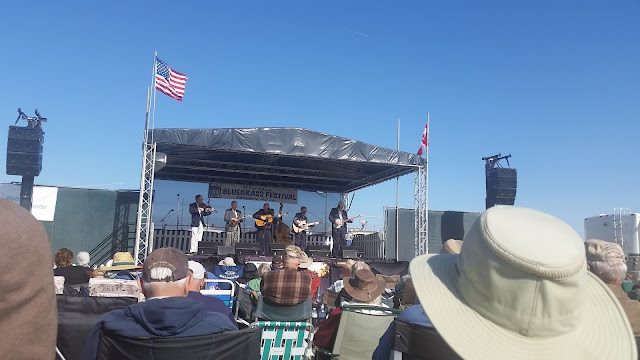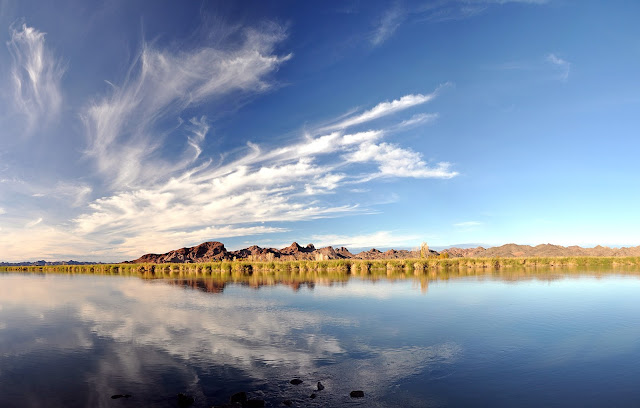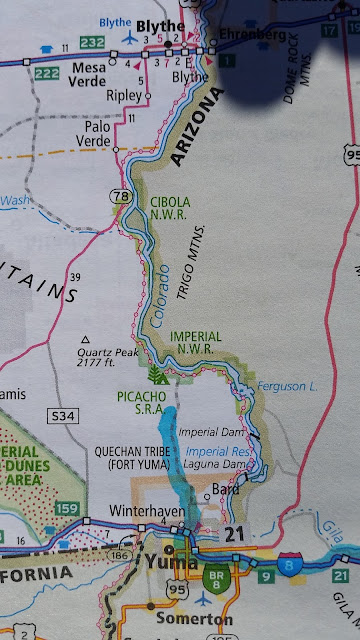 |
| Stone dam in Huecos Tanks State Historical Park |
Feeling proud for reaching Guadalupe Peak, Sarah and I rewarded ourselves with a short drive of only about 90 miles further west to Hueco Tanks State Historical Park just east of El Paso. This was a must stop because it is an area rich in ancient pictographs, which those who follow this blog know, Sarah and I enjoy viewing these ancient works and seek them out whenever possible. While the internet gives us access to a lot information, that information isn't always complete or accurate. This was the case at Hueco Tanks State Historical Park. Prior to arriving we knew that some areas were closed except to those on a guided tour, but we didn't know that hiking in the park is restricted to a limited number of visitors who register on a first come first served basis each morning. While we were allowed to go to our campsite, we were restricted to the roads in the campground until we registered with the park office the next morning. This required that we get up early and register at the park station to obtain a pass the day allowing us to explore the half of the park not closed except to those on the guided the tours. The reason for all the regulations is that at one time as many as 30,000 visitors a week were destroying this small park.
 |
| Pictograph relating the raid by Apaches |
We were also surprised to learn that access into and out of the park was restricted after 6PM. The stearn Park Ranger informed us that we could not leave the park except in case of an emergency after the gate was locked at 6PM. After our stay in Guadalupe we were low on provisions and needed to drive to El Paso to re-stock. Fortunately, the campground host understood and told us not to worry about returning after the curfew.
We arrived at the Ranger Station in the morning at the appointed time and were granted access to the non-guided area. The park is unique in that it is an area of ancient limestone ocean bottom through which volcanic magma erupted. As the limestone eroded, huge mountains of lava rose from the former sea bed. Within the park are three distinct "peaks", north, east and west. We were allowed to roam the north peak at will and we shared it with rock climbers who come to boulder on the rock.
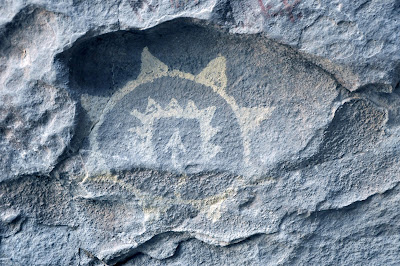
It didn't take long to understand why this park has such severe restrictions. Many of the pictographs and petroglyphs in the northern area have been defaced over the last 100 years. We only found about six sites with pictographs, but we enjoyed climbing the steep rocks and observing all the huecos, deep depressions in the rocks that hold water and create micro-oasis in the desert.
After seeing the pictographs accessible without the guide, we enrolled for the next day's tour. We were not disappointed. Our volunteer guide, Jim, informed us that the tour's description says it lasts two hours. He said that, unless anyone in the group was on a tight schedule, the tour might be as long as three hours. There were no objections, and Jim took us on a leisurely and informative three and a half hour tour of the some very fine pictographs, not to mention the incredible scenery created by geologic forces millions of years ago.
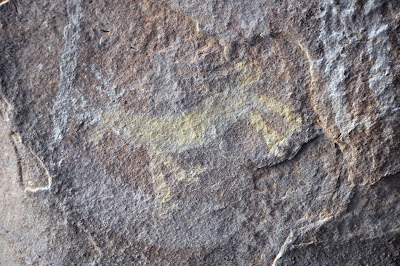 |
| Yellow deer with white antlers |
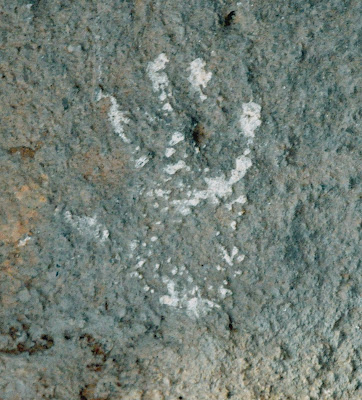 |
| Handprint of young girl at the time of her coming of age |
It was December 23, and we were to meet our co-conspirators on Christmas Eve in Bisbee, Arizona. When Sarah and I travel, we try not to have rigid plans. But, we made reservations for a week in Bisbee in order to share the holiday with our dear friends, Liz and Jack. That left us one more night on the road before making Bisbee. We usually don't know where we will spend the next night until the evening before departing our current location. I spend time with a map looking for state parks, wildlife refuges and National Parks. A few days before departing Guadalupe Mountains National Park, I spied Pancho Villa State park. The park is located in the center of the town of Columbus, New Mexico which is directly on the border with Mexico. However, I became skeptical of this town when I researched it using the internet. It seems the town nearly went bankrupt about ten years ago when a number of important people in town were found to have been criminals who ran guns to the drug cartels just across the border in Mexico and played hanky panky with the town finances. Further research on the internet revealed that the narco-criminals on the Mexican side were a rather brutal and murderous bunch. I had almost crossed this town off my list until I talked with other nomads who assured me that what I had read was ancient history and it was a perfectly safe place to visit.
 |
| Pancho Villa State Park is an old Army Fort and Customs Station |
We arrived at Pancho Villa State Park late in the afternoon, and selected one of the very large campsites available. The next morning, since Bisbee was only a few hours away, we decided to treat ourselves to breakfast in a local restaurant and then avail ourselves of the computer services of the local library. We needed to print and mail forms to cancel one of our health insurance policies due to achieving the age at which we qualify for Medicare. Unfortunately, all three cafes in town were closed on this morning of Christmas Eve. However, the library attendant told us that the Pink Store across the border in Mexico was open and serves a great huevos rancheros. She told us that we could park just on the US side and walk across the border. So, we drove the Mary Joan to the border, parked her in a large lot and walked into Mexico.
 |
| Statue of Pancho Villa in Puerto Palomas, Mexico across the border from Columbus, NM |
 |
| Great coffee and huevos rancheros at the Pink Store in Palomas |
The Pink Store is a large store that sells Mexican craftworks to tourists and has a fine restaurant. We arrived while the restaurant workers were still preparing to open for the day. That gave Sarah and I time to peruse the huge assortment of items for sale. We succumbed and bought a colorful chased tin and ceramic framed mirror that should look perfect in our half bath. With shopping finished, we enjoyed some of the finest coffee we have had to accompany our huevos rancheros. Just as we finished our breakfast Sarah received a text from Liz and Jack, who left Rhode Island just four days earlier, informing us that they were closing in on Bisbee. We hit the road and arrived just about an hour after their landing.
 |
Near Rodeo, on the border of New Mexico and Arizona
|
 |
| Bisbee, Arizona. |
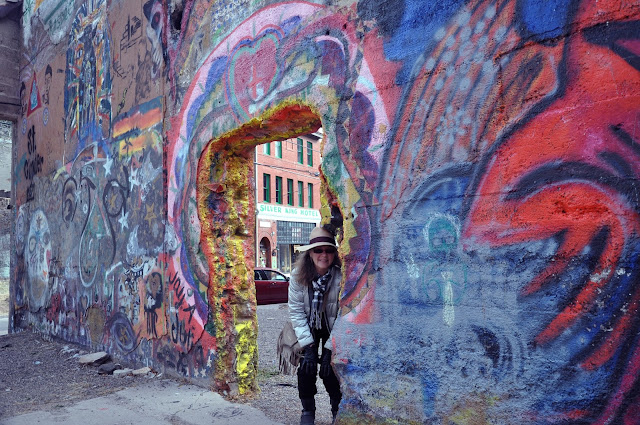 |
| Wall art is everywhere in Bisbee |
Bisbee is a former mining town that could return to its roots if the demand for and the price of copper ever sees a dramatic increase. From the late 19th century until 1975, Bisbee produced billions of tons of copper as well as significant amounts of gold, silver and lead. At its peak, it was the largest city west of St. Louis. Since the mines closed Bisbee has survived as a cool mountain oasis high in the southwest desert.
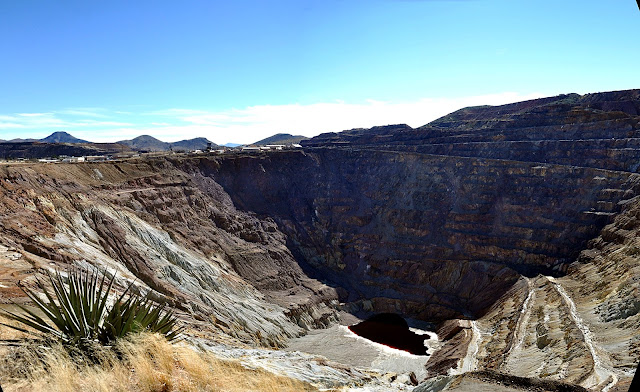 |
| Pit mine at Bisbee |
There are fine restaurants, hotels, antique stores and art galleries that attract tourists. However, the allure of Bisbee is that it is a very small community that welcomes visitors like few places we have visited. We experienced this openness when a fellow camper who has been coming to Bisbee for more than a decade invited us to a potluck music get together in the town. In just a few hours while playing music we became members of the community receiving invitations for other gatherings and expressions of disappointment that we were not going to stay longer.
 |
| Making music |
We arrived on Christmas Eve and spent the week with our friends, Liz and Jack. Despite the cooler than average temperatures, we explored the streets and hiked the canyons and the peaks surrounding the old town of Bisbee.
 |
| Hiking in the Bisbee canyons |

One of hundreds of open mine shafts
 |
| Bisbee from Miracle Mountain |
The hill across the street from our campground appeared to be just a few hundred feet above the canyon floor, just a short hike. However, owing to the steepness of the canyon walls we didn't see that the real summit was many hundreds of feet higher. Our thirty minute hike turned into a three hour sojourn to the summit of Miracle Mountain where we were enthralled with the efforts of those who sought to create memorials and shrines. Local legend told us that the first shrine was for Alfonso Velasquez whose illnesses were cured after the erection of a devotional shrine. Since then others have added to the shrines on the summit.
 |
| Miracle Mountain Summit |
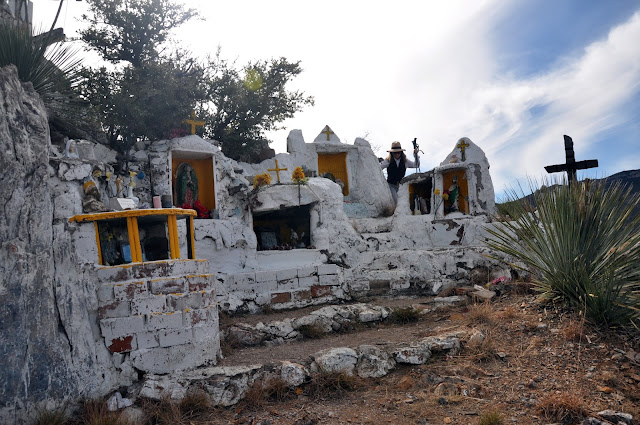 |
| Shrine of Alfonso Velasquez |
At the entrance to Bisbee's canyon is the small one street long village of Lowell. It appears that time stopped in 1975. There is a Coop market, breakfast cafe and a number of storefronts with many vintage motorcycles along with antique cars parked out front.
 |
| Lowell |
Together with Liz and Jack, Sarah and I rang in the New Year drifting between three venues offering good live music and fine company after a wonderful dinner at the Copper Queen. Thanks, Jack and Liz for sharing the cheer.
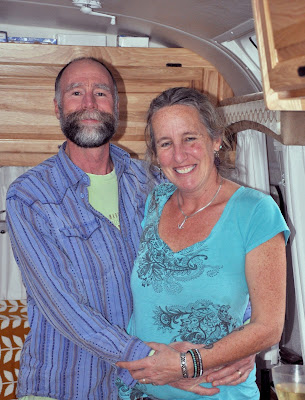 |
| Christmas Eve with Liz and Jack |
We departed Bisbee on the first day of 2016.
Stay tuned.
